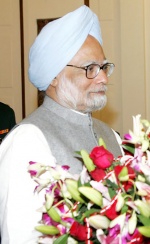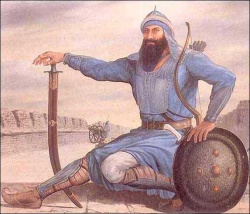SikhiWiki:Proposed Featured Articles: Difference between revisions
Hari singh (talk | contribs) No edit summary |
|||
| Line 1: | Line 1: | ||
{{Tocright}} | |||
==PMA 1== | |||
{{aowh|Why I wear a Turban?}} | {{aowh|Why I wear a Turban?}} | ||
| Line 5: | Line 8: | ||
Most people in the west who wear the turban are [[Sikh]]s. All Sikhs, but particularly male Singhs are required to don the [[Dastaar]] due to the pronouncement in 1699 by the tenth Sikh master [[Guru Gobind Singh]]. Dastaar, is the native [[Punjabi]] term used to refer to this headdress. Even 300 years on, it is in compliance to the [[Hukam]] (or order) of this supreme Sikh leader that all Sikhs today wear the dastaar. It is in honour and obedience to this one person! The Sikh prime minister of [[India]], [[Dr Manmohan Singh]], displays his sky blue trademark turban out of respect for the [[Sikh Guru]]; the famous record breaking, 95-year-old marathon runner, [[Fauja Singh]] proudly wears his dastaar in honour of the tenth Sikh teacher; [[Bhagat Puran Singh]] the humble humanist and philanthropist used to don a simple [[turban]] in respect of the Sikh master. Why do the Sikhs go to all this trouble so many years after the diktat? | Most people in the west who wear the turban are [[Sikh]]s. All Sikhs, but particularly male Singhs are required to don the [[Dastaar]] due to the pronouncement in 1699 by the tenth Sikh master [[Guru Gobind Singh]]. Dastaar, is the native [[Punjabi]] term used to refer to this headdress. Even 300 years on, it is in compliance to the [[Hukam]] (or order) of this supreme Sikh leader that all Sikhs today wear the dastaar. It is in honour and obedience to this one person! The Sikh prime minister of [[India]], [[Dr Manmohan Singh]], displays his sky blue trademark turban out of respect for the [[Sikh Guru]]; the famous record breaking, 95-year-old marathon runner, [[Fauja Singh]] proudly wears his dastaar in honour of the tenth Sikh teacher; [[Bhagat Puran Singh]] the humble humanist and philanthropist used to don a simple [[turban]] in respect of the Sikh master. Why do the Sikhs go to all this trouble so many years after the diktat? | ||
The [[dastaar]] comes in many different colours and styles and to the keen eye, each turban is different. Some are simple but regal; others may be bright and sporty; yet others may be stylish and extravagant – each one has it own special and unique statement. Every morning, most [[Sikh|Sikh man]] and many [[Sikh women]], spend some 5 to 20 minutes to comb their long hair and then carefully handicraft the link to their [[Gurus]] – a daily reminder of their heritage and its responsibilities. | The [[dastaar]] comes in many different colours and styles and to the keen eye, each turban is different. Some are simple but regal; others may be bright and sporty; yet others may be stylish and extravagant – each one has it own special and unique statement. Every morning, most [[Sikh|Sikh man]] and many [[Sikh women]], spend some 5 to 20 minutes to comb their long hair and then carefully handicraft the link to their [[Gurus]] – a daily reminder of their heritage and its responsibilities. {{aowf|Why I wear a Turban?}} | ||
==Proposed Male Article== | ==Proposed Male Article== | ||
===PMA | ===PMA 2=== | ||
[[Banda Singh Bahadur]]...... | Suggested by [[user:paapi]] in June 2007 | ||
{{aowh|Banda Singh Bahadur}} | |||
[[Image:Banda_Singh_Bahadur.jpg|thumb|250px|right|Banda Singh Bahadur]] | |||
'''Baba Banda Singh Bahadur (1670-1716)''' (Lachhman Dev alias Madho dass Bairagi) , of Jammu region, is revered as one of greatest warriors as well as one of its most hallowed martyrs of the [[Khalsa]] Army who were fighting against the Cruel [[Muslim]] rule and their tyranny. His confrontation with the [[Muslim]] administration in Northern [[India]], though brief, was strong enough to shake its foundations. The agrarian uprising that he led in the [[Punjab]] was the foundation on which the [[Dal Khalsa]], the Sikh [[Misl]]s and Maharaja Ranjit Singh built the edifice which finally culminated with [[Ranjit Singh]] capturing [[Lahore]] in 1799 and establishing the Sikh Kingdom of the [[Punjab]]. | |||
Banda was born in a Minhas Rajput family on October 16, 1670 at Rajouri in the Jammu region of [[Jammu]] and [[Kashmir]]. He was named Lachman Dev. Wrestling, horseback riding, and hunting were his major hobbies. As a young man, he shot a doe and was shocked to watch the mother and her aborted fawn writhing in pain and dying. After this gloomy scene, he had a change of heart. He left his home and became a disciple of a Bairagi Sadhu, Janaki Das, who gave him the name, Madho Das. In the company of the Sadhus he travelled through Northern [[India]] and finally arrived at [[Nanded]] (in present-day Maharashtra), situated on the bank of the river [[Godavari]], where he built a hut to meditate upon God. {{aowf|Banda Singh Bahadur}} | |||
===PMA 3=== | ===PMA 3=== | ||
[[ | [[Baba Gurditta]]............by [[user:paapi]] | ||
===PMA 4=== | ===PMA 4=== | ||
Suggestion by [[user:paapi]] in June 2007 | |||
{{aowh|Nawab Kapur Singh}} | |||
[[Image:Kapursinghnawaaab.jpg|thumb|right|200px|Nawab Kapur Singh]] | |||
'''Nawab Kapur Singh Virk''' (1697-1753) is considered one of the most revered, pivotal and legendary figures in [[Sikh history]], under whose leadership, decisions and courage,the tiny Sikh community traversed through some the darkest periods of its history. The founding father of the [[Sikh Confederacy]] & [[Sikh Empire]], he was also the founder of the [[Dal Khalsa]]. Alongside [[Banda Bahadur]], he laid the foundations of the Sikh Empire. Today, he is regarded by Sikhs to be of equal importance to [[Banda Singh Bahadur]]. | |||
The period, starting from the massacre in [[Delhi]] of Banda in 1716 and his seven hundred followers, was followed by severe action against the [[Sikh]]s, including massacres of young men, women and children. However, every fresh adversity only stimulated their will to survive, planned and led by Nawab Kapur Singh. Many Sikh scholars have predicted that had it not been for the leadership of Nawab Kapur Singh, the tiny Sikh community of the time would not have survived and would have been massacred. Today, significant number of Sikhs commemorate and celebrate his birthday as a debt of gratitude and deep respect. | |||
{{aowf|Nawab Kapur Singh}} | |||
===PMA 5=== | |||
[[Bhai Kuram]]...............by [[user:paapi]] | [[Bhai Kuram]]...............by [[user:paapi]] | ||
Revision as of 19:02, 28 June 2007
PMA 1

Most people in the west who wear the turban are Sikhs. All Sikhs, but particularly male Singhs are required to don the Dastaar due to the pronouncement in 1699 by the tenth Sikh master Guru Gobind Singh. Dastaar, is the native Punjabi term used to refer to this headdress. Even 300 years on, it is in compliance to the Hukam (or order) of this supreme Sikh leader that all Sikhs today wear the dastaar. It is in honour and obedience to this one person! The Sikh prime minister of India, Dr Manmohan Singh, displays his sky blue trademark turban out of respect for the Sikh Guru; the famous record breaking, 95-year-old marathon runner, Fauja Singh proudly wears his dastaar in honour of the tenth Sikh teacher; Bhagat Puran Singh the humble humanist and philanthropist used to don a simple turban in respect of the Sikh master. Why do the Sikhs go to all this trouble so many years after the diktat?
The dastaar comes in many different colours and styles and to the keen eye, each turban is different. Some are simple but regal; others may be bright and sporty; yet others may be stylish and extravagant – each one has it own special and unique statement. Every morning, most Sikh man and many Sikh women, spend some 5 to 20 minutes to comb their long hair and then carefully handicraft the link to their Gurus – a daily reminder of their heritage and its responsibilities. .....More
Proposed Male Article
PMA 2
Suggested by user:paapi in June 2007
Baba Banda Singh Bahadur (1670-1716) (Lachhman Dev alias Madho dass Bairagi) , of Jammu region, is revered as one of greatest warriors as well as one of its most hallowed martyrs of the Khalsa Army who were fighting against the Cruel Muslim rule and their tyranny. His confrontation with the Muslim administration in Northern India, though brief, was strong enough to shake its foundations. The agrarian uprising that he led in the Punjab was the foundation on which the Dal Khalsa, the Sikh Misls and Maharaja Ranjit Singh built the edifice which finally culminated with Ranjit Singh capturing Lahore in 1799 and establishing the Sikh Kingdom of the Punjab.
Banda was born in a Minhas Rajput family on October 16, 1670 at Rajouri in the Jammu region of Jammu and Kashmir. He was named Lachman Dev. Wrestling, horseback riding, and hunting were his major hobbies. As a young man, he shot a doe and was shocked to watch the mother and her aborted fawn writhing in pain and dying. After this gloomy scene, he had a change of heart. He left his home and became a disciple of a Bairagi Sadhu, Janaki Das, who gave him the name, Madho Das. In the company of the Sadhus he travelled through Northern India and finally arrived at Nanded (in present-day Maharashtra), situated on the bank of the river Godavari, where he built a hut to meditate upon God. .....More
PMA 3
Baba Gurditta............by user:paapi
PMA 4
Suggestion by user:paapi in June 2007
Nawab Kapur Singh Virk (1697-1753) is considered one of the most revered, pivotal and legendary figures in Sikh history, under whose leadership, decisions and courage,the tiny Sikh community traversed through some the darkest periods of its history. The founding father of the Sikh Confederacy & Sikh Empire, he was also the founder of the Dal Khalsa. Alongside Banda Bahadur, he laid the foundations of the Sikh Empire. Today, he is regarded by Sikhs to be of equal importance to Banda Singh Bahadur.
The period, starting from the massacre in Delhi of Banda in 1716 and his seven hundred followers, was followed by severe action against the Sikhs, including massacres of young men, women and children. However, every fresh adversity only stimulated their will to survive, planned and led by Nawab Kapur Singh. Many Sikh scholars have predicted that had it not been for the leadership of Nawab Kapur Singh, the tiny Sikh community of the time would not have survived and would have been massacred. Today, significant number of Sikhs commemorate and celebrate his birthday as a debt of gratitude and deep respect. .....More
PMA 5
Bhai Kuram...............by user:paapi
PMA 5
Makhan Shah Labana.......by user:paapi


